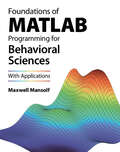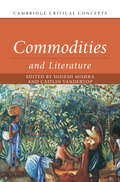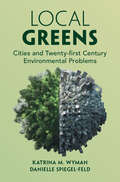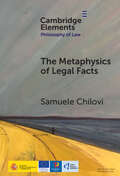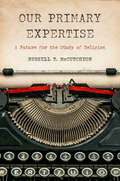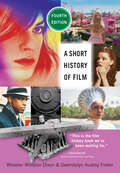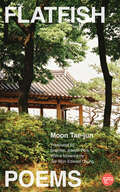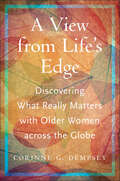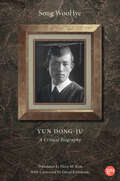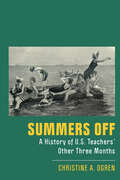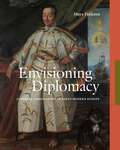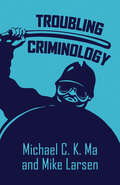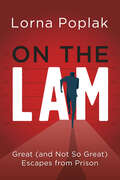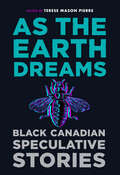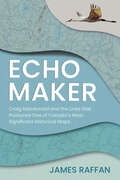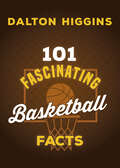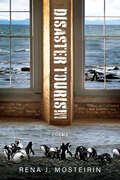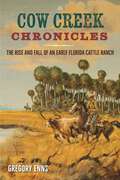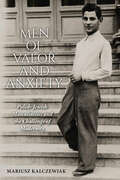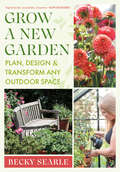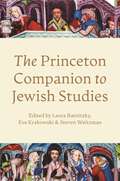- Table View
- List View
Foundations of MATLAB Programming for Behavioral Sciences: With Applications
by Maxwell MansolfThis textbook introduces the fundamentals of MATLAB for behavioral sciences in a concise and accessible way. Written for those with or without computer programming experience, it works progressively from fundamentals to applied topics, culminating in in-depth projects. Part I covers programming basics, ensuring a firm foundation of knowledge moving forward. Difficult topics, such as data structures and program flow, are then explained with examples from the behavioral sciences. Part II introduces projects for students to apply their learning directly to real-world problems in computational modelling, data analysis, and experiment design, with an exploration of Psychtoolbox. Accompanied by online code and datasets, extension materials, and additional projects, with test banks, lecture slides, and a manual for instructors, this textbook represents a complete toolbox for both students and instructors.
Commodities and Literature (Cambridge Critical Concepts)
by Caitlin Vandertop Sudesh MishraGlobal commodities, from tea and sugar to coal and oil, have had an enduring presence in literary texts. Commodity cultures have also shaped literary ones, from the early influence of the literary coffeehouse to the serial novels facilitated by print's own emergence as a mass commodity. This book offers an accessible overview of the many intersections between literature and commodities. Tracing the stories of goods as diverse as coffee, rum, opium, guano, oil and lithium, as they appear across a range of texts, periods, areas, and genres, the chapters bring together existing scholarship on literature and commodity culture with new perspectives from world-literary, postcolonial and Indigenous studies, Marxist and feminist criticism, the environmental and energy humanities, and book history. How, this volume asks, have commodities shaped literary forms and modes of reading? And how has literature engaged with the world-making trajectories and transformations of commodities?
Local Greens: Cities and Twenty-first Century Environmental Problems
by Katrina M. Wyman Danielle Spiegel-FeldAs the federal government failed to take ambitious action to limit climate change in the early 21st century, many cities in the US pledged to step into the void. Networks of city governments and philanthropists offered support and cities invested their own resources in sustainability offices. However, cities made limited progress in reducing their greenhouse gas emissions in the first two decades of this century. Local Greens provides a clear-eyed analysis of the potential for big city governments to address society's most pressing environmental problems in the near term. Through original case studies of New York's environmental policy efforts in the early 21st century, the book examines the promise and perils of turning to cities to tackle climate change. Drawing on an analysis of cities' strengths and weaknesses, the book outlines a high-level agenda for urban environmental policy for a sustainable future.
The Metaphysics of Legal Facts (Elements in Philosophy of Law)
by Samuele ChiloviThis Element tackles the question of how – in what way, and in virtue of what – facts about the legal properties and relations of particulars (such as their rights, duties, powers, etc.) are metaphysically explained. This question is divided into two separate issues. First, the Element focuses on the nature of the explanatory relation connecting legal facts to their metaphysical determinants. Second, it looks into the kinds of entities that figure in the explanation of legal facts. In doing so, special attention is paid to the role that laws, or legal norms, play in such explanations. As it turns out, there are different ways in which legal facts might be explained, all of which have something to be said in their favor, and none of which is immune from problems. This title is also available as Open Access on Cambridge Core.
Our Primary Expertise: A Future for the Study of Religion
by Russell T. McCutcheonOur Primary Expertise: A Future for the Study of Religion brings the author full circle—from his first book in 1997, on how claims that religion was unique were used to establish the North America field to his present argument that its future is instead based on the degree to which its findings can be applied in a wide assortment of areas, both inside and outside of academia. Its previously uncollected essays, all with new introductions that frame this timely argument, make plain that longstanding critiques of how scholars go about their work have always been about the study of religion’s odd home in the humanities—a place that’s increasingly vulnerable in today’s university. Calling on members of the field not just to revise their research methods but also the ways that they train the next generation, Our Primary Expertise is the only work in the field taking seriously that scholars of religion can help to secure the future of their own field, if only they’re prepared to see “the life of the mind” as a rhetoric that they can no longer afford.
Embodying the Revolution: The Hebrew Experience and the Globalization of Modern Sports in Interwar Palestine
by Ofer IdelsThis original and thought-provoking study offers a fresh perspective on Zionism by exploring Hebrew culture’s ambivalent attitude toward modern sports. Drawing on extensive archival sources and contemporary literary theories, it focuses on Zionism’s surprising anxiety toward sports during the interwar heyday of “muscular Judaism,” revealing an unusual society in which athletes failed to attain national pride and distinction. Addressing themes such as the body, language, space, immigration, internationalism, amateurism, gender, and militarization, Embodying the Revolution presents an innovative reading of Jewish life in Mandate Palestine, linking the marginalization of sports to the meaning and experience of the Zionist Revolution. Idels' compelling interpretation of the appeal of sports, selfhood, and the compromises inherent in radical aspirations—narrated from the periphery of the interwar global rise of sports—challenges contemporary assumptions that dismiss ideology as an elitist myth.
A Short History of Film, Fourth Edition
by Wheeler Winston Dixon Gwendolyn Audrey FosterA Choice Significant University Press Title for Undergraduates This updated and expanded edition of A Short History of Film provides an accessible overview of the major movements, directors, studios, and genres from the 1880s to the present. Succinct yet comprehensive, with more than 250 rare stills and illustrations, this edition provides new information on contemporary horror, comic book, and franchise films; issues surrounding women and minority filmmakers; the effects of the COVID-19 pandemic on movies worldwide; the shift from film to digital production; the rising use of artificial intelligence in cinema; and the impact of streaming on the industry. Beginning with the precursors of moving pictures, Wheeler Winston Dixon and Gwendolyn Audrey Foster lead a fast-paced tour through the invention of the kinetoscope, the introduction of sound and color between the two world wars, and ultimately the computer-generated imagery of the present day. They detail significant periods in world cinema, including the creation of early major industries in Europe, the dominance of the Hollywood studio system in the 1930s and 1940s, and the French New Wave of the 1960s. They also highlight independent efforts in developing nations and the corresponding more personal independent film movement that briefly flourished in the United States. Compact and easily readable, this is a vital history of international cinema is a one-stop resource for students, teachers, and general readers alike.
Flatfish: Poems, A Bilingual Edition (DITTA: Korean Humanities in Translation)
by Moon Tae-jun Tae-jun Moon Tae-Jun MoonIn his poetry collection, Flatfish, Moon Tae-jun offers an aesthetic that emphasizes the author’s exploration of the inner self. At times sparse and allusive, his poems use blank space and other stylistic considerations to convey a voice and thought that ranges from the contemplative to the surreal and absurd. Moon’s poems suggest Buddhist ideologies, natural images, and Korean temples, as the collection explores individual experiences within the context of a search for understanding a greater whole. While Korea is certainly the setting of these poems, the works remain largely free of cultural-specific imagery and are, instead, naturalistic or universal. This first bilingual edition is a critical resource for students, poets, translators, and general readers alike. English-Korean Bilingual Edition 영-한 이중언어판
A View from Life's Edge: Discovering What Really Matters with Older Women Across the Globe (Global Perspectives on Aging)
by Corinne G. DempseyIn today’s death-denying, success-driven society, older women’s countercultural voices call for our attention. Recounting emotionally charged conversations from across the world, A View from Life’s Edge reflects on women’s comfort with impending death, gratitude forged by catastrophe, and humility that makes way for wonder. Speaking with nearly one hundred women over the age of eighty in four locations—northern Iceland, south India, a retirement community in California, and a convent in upstate New York—Corinne G. Dempsey finds that, as we near life’s end, we gain clarity about what really matters in life. Women’s stories and reflections, in which sorrow and loss are central to a life well lived, help to expand our sense of what it means to be human. Drawing on the paradoxical wisdom of world religions and mystical traditions to frame late-life tendencies across cultures, Dempsey portrays these accounts as a corrective to mainstream values that defeat and diminish us. Dempsey encourages us to turn away from ageist fears rather than denying life’s inevitable end. Learning from older women’s perspectives, we might move their edge-of-life views closer to the center.
Yun Dong-ju: A Critical Biography (DITTA: Korean Humanities in Translation)
by Song WooHye WooHye SongHistorian and novelist Song WooHye chronicles the life of Yun Dong-ju (1917-1945), one of the most beloved and important poets in the modern Korean literary canon, widely considered Korea's "National Poet". Beginning with the history of the North Gando region (now Yanbian, China), where Yun was born, and ending with facts behind the publication of his only and posthumous poetry collection, Sky, Wind, Star, and Poem, this critical biography elucidates who Yun Dong-ju really was, with factual descriptions of the bleak and turbulent period of Japan’s colonization of Korea. While first working on the book in the 1980s, Song had interviewed the poet’s surviving relatives and friends, most of whom have since passed away. Without her interviews, these important first-hand accounts would have been lost. Song had an added advantage of an “insider,” as she is a niece of Song Mong-gyu, who was the poet’s first cousin and inseparable friend for life. Incorporating newly discovered materials and using interviews with the beloved poet's family and friends, this biography is the most comprehensive, definitive biography of Yun Dong-ju to date, now available in English for the first time. This book is published with the support of the Literature Translation Institute of Korea (LTI Korea).
Summers Off?: A History of U.S. Teachers' Other Three Months (New Directions in the History of Education)
by Christine A. OgrenSince the nine-month school year became common in the United States during the 1880s, schoolteachers have never really had summers off. Administrators instructed them to rest, as well as to study and travel, in the interest of creating a compliant workforce. Teachers, however, adapted administrators’ directives to pursue their own version of professionalization and to ensure their financial well-being. Summers Off explores teachers’ summer experiences between the 1880s and 1930s in institutes and association meetings; sessions at teachers colleges, Black colleges, and prestigious universities; work for wages or their family; tourism in the U.S. and Europe; and activities intended to be restful. This heretofore untold history reveals how teachers utilized the geographical and psychological distance from the classroom that summer provided, to enhance not only their teaching skills but also their professional and intellectual independence, their membership in the middle class, and, in the cases of women and Black teachers, their defiance of gender and race hierarchies.
Envisioning Diplomacy: Japanese Ambassadors in Early Modern Europe
by Mayu FujikawaIn the late sixteenth and early seventeenth centuries, Japan sent its first diplomatic delegations to visit the popes and dignitaries of Europe. European artists portrayed these historic ambassadors—the Tenshō embassy (1582–90) and the Keichō embassy (1613–20)—in numerous oil paintings, frescoes, drawings, and prints. Envisioning Diplomacy analyzes these images—including newly discovered and lost works—within their cross-cultural and diplomatic contexts.Drawing on extensive and geographically expansive archival research, art historian Mayu Fujikawa investigates how the embassies were received and either assimilated or differentiated at European courts. She demonstrates how delegates’ gifts to their hosts, their Europeanized kimonos, and the Western clothes they wore while traveling functioned as tools of soft diplomacy. Fujikawa also shows how printed materials functioned much as news does today, promoting the embassies widely and conveying information about the guests and their striking physical appearance.Envisioning Diplomacy offers a fascinating look at the political, social, and cultural meanings of visual materials created around the embassies and should be of great interest to scholars, students, and general readers interested in early modern European art and history, costume history, diplomatic history, and Japanese and global studies.
I Make My Own Fun: A Novel
by Hannah BeerThe sinister side of celebrity fandom is inverted in this razor-sharp debut following the descent of the world’s most beloved movie star into a dark and disastrous obsession—perfect for readers of You and My Sister, the Serial Killer. Everyone knows Marina, the A-list movie star. But very few know Marina, the absolute monster. Years at the top have proved that whatever Marina wants, she gets. But when she meets bartender Anna, Marina discovers something that can’t be bought: Anna’s affection. As Anna remains unmoved, Marina’s advances become more desperate, and her obsession more dangerous. The price of fame is heavy—and someone will have to pay for it …
Troubling Criminology
by Michael C. Ma Mike LarsenCrime doesn’t happen in a vacuum, but in the complex world we all live in. In Troubling Criminology, professors Michael C. K. Ma and Mike Larsen untangle the discipline of criminology in a series of insightful conversations. Rather than presenting a fixed canon of knowledge, this book encourages readers to draw on their own experiences and perspectives, fostering dialogue and collaborative thinking. It examines how crime, justice, and deviance are socially constructed, shaped by historical and cultural contexts, and influenced by power, inequality, and systemic oppression. Perfect for students and educators alike, this book is not just a textbook—it’s an invitation to join an ongoing conversation about what criminology means today to help us envision a more just future.
On the Lam: Great (and Not So Great) Escapes from Prison
by Lorna PoplakFascinating stories of the age-old tug-of-war between prisons struggling to keep inmates inside and escapees desperate to get out. A convict who returned to the prison he had recently escaped from in a vain attempt to foment a mass breakout; a murderer on the run who veered from folk hero to persona non grata after killing a police dog; a fugitive from the United States who was seized in Canada after being featured on America’s Most Wanted; a repeat escapee who shot himself, preferring death to recapture; a serial killer on the prowl in a small community — these are just a few of the felons whose prison break escapades continue to enthral and terrify. Along with probing the origins, structure, and shortcomings of a variety of historic and contemporary correctional institutions, On the Lam brings into sharp focus the attempts — sometimes successful, occasionally deadly — of masterminds, tricksters, scoundrels, and innocents to claw their way to freedom.
As the Earth Dreams: Black Canadian Speculative Stories
by Terese Mason PierreA ground-breaking anthology of haunting speculative stories by contemporary Black Canadian writers that explore growth, futurity, and joy. Edited by esteemed poet Terese Mason Pierre, this bold and innovative anthology of speculative short fiction reveals and uplifts the spectacular imaginings, reveries, reflections, experiments, and hopes of Black writers in Canada. A masseuse attends her mother’s fourth funeral, only to encounter family she’s never met. A postdoc instructor navigates an almost-life in an Elsewhere realm of safety and comfort. After societal collapse, an immigrant leaves her precarious station, and her memories, behind. A woman isolating from a new virus starts hallucinating. A young nanny accepts a job with a peculiar employer in search of immortality. A medium is tasked with summoning a spirit that hits too close to home. And two teenagers test a friendship over magic carpet flying practice. These ten breathtaking stories explore natural and urban landscapes, living and dead relationships, economic catastrophe, love, and desire—all while celebrating the persistent and ever-changing self, and envisioning beautiful Black futures. Featuring stories by: Trynne Delaney francesca ekwuyasi Whitney French Aline-Mwezi Niyonsenga Chimedum Ohaegbu Suyi Davies Okungbowa Chinelo Onwualu Lue Palmer Terese Mason Pierre Zalika Reid-Benta
Echo Maker: Craig Macdonald and the Lives that Produced One of Canada's Most Significant Historical Maps
by James RaffanIn an example of truth and reconciliation put into practice, Craig Macdonald spent decades creating a unique map of Temagami, developed through trust and experience, in partnership with the Teme-Augama Anishnabai. James Raffan’s biography of Craig Macdonald and how the Historical Map of Temagami came to be is a remarkable tale. In the mid-1960s, Macdonald began interviewing and travelling with Indigenous trappers and travellers. He became familiar with Anishinaabemowin and built a lasting bond with the traditional knowledge holders. Returning year after year to map the land, Macdonald painstakingly plotted traditional placenames, original shorelines, elevations, and traditional summer and winter travel routes — including the documentation of more than twelve hundred canoe portages and winter snowshoe trails. His map is unique in the Canadian cartographic canon, and its genesis is a story that has never been told, until now.
101 Fascinating Basketball Facts (101 Fascinating Facts)
by Dalton Higgins101 thought-provoking basketball stories and trivia to delight fans. Author provocateur Dalton Higgins provides 101 reasons why basketball has captured the imagination of sports enthusiasts around the globe. Higgins unpacks the myths and realities behind the world’s second most popular sport, breaking down with precision all kinds of wildly interesting and obscure basketball facts tied to height, gender, geography, race, economics, and everything in between. From sneakers to salacious tidbits, Higgins offers takes on ageold issues and debates: Can white men jump now? Have three-pointers become the new layup? Should traditional ten-foot rims be raised? Who is the GOAT? Why is Canada a basketball hot spot? Is the WNBA the next big thing? Are hip hop and hoops kissing cousins?
Disaster Tourism
by Rena J. MosteirinDisaster Tourism is a poetry collection that offers glimpses of disasters at once personal and global. The term “disaster tourism” refers to the offensive practice of visiting sites after a cataclysm. Steeped in violence, injustice, immigration stories, and accounts of police brutality, Disaster Tourism gives us a lens to re-imagine our dangerous surroundings in the hopes that we strive toward a better existence, even when it hurts.Born of a Cuban refugee father and a mother whose homeland of Gottschee is now considered Slovenia, Rena J. Mosteirin’s identity and poetry are shaped by the respective lost homelands of her parents. Bold, unflinching, and lyrical, yet laced with a disarmingly clever and sometimes wicked sense of humor, these poems sift through various sites and forms of devastation to reveal moments of love and joy. Mosteirin uses observational wit and arresting clarity to bring us closer to the fires burning all around us. Yet, through it all, there is the interconnectedness of family and community – including our world community – entreating us to carry on with an eye toward helping each other through this challenging life.
Cow Creek Chronicles: The Rise and Fall of an Early Florida Cattle Ranch
by Gregory EnnsA boom-to-bust generational saga of a pioneer family and their cattle empire Cattle ranching has long been a major force in Florida, covering over 12 percent of the state’s lands. In Cow Creek Chronicles, journalist Gregory Enns explores this history through the century-long saga of the Raulerson family, who built a cattle empire at Cow Creek Ranch between Fort Pierce and Okeechobee.The Raulersons were a family of pioneers that moved south to Florida during the nineteenth century. Family patriarch Frank Raulerson established the ranch in 1923. As the cattle herd grew and fences were built, Seminole communities that had lived near the creek in thatched huts called chickees were forced off the land to nearby towns and reservations, and this book includes their stories. At its height in the 1960s, the 23,000-acre Cow Creek Ranch, operated by Frank’s granddaughter and heir Jo Ann Raulerson Sloan, boomed under the supervision of a core group of cowboys using modern agricultural methods. As the years went by, Jo Ann’s husband, TL Sloan, mismanaged expenses and mired the ranch in debt, and the family sold off the land in parcels—many of which are now conservation areas.In this narrative, readers will gain insight into how ranches were first established in Florida, including how cattle were managed and breeds developed. Enns opens a window into the lives of ranch hands and cowboys, highlighting traditions such as roundups, cattle drives, parades, and rodeos, as well as folkways such as cooking and handcrafts. He also draws attention to the history of the Cow Creek band of Florida Seminoles, including their legendary heroine Emateloye Estenletkvte (Polly Parker). Cow Creek Chronicles weaves together many strands in a unique history of the modern settlement of Florida.
Mainstreaming Palestine: Cinematic Activism and Solidarity Politics in the United States
by Umayyah CableA history of cinema&’s role in popularizing the politics of Palestinian liberation For decades, Arab American activists and allies have used film, video, and multimedia to mobilize support for the Palestinian cause in the United States. In this detailed history of cinema&’s role within the broader solidarity movement, Umayyah Cable analyzes the various strands of cinematic activism that have helped move Palestinian liberation politics from the periphery and into the mainstream. Cable charts the shifting discourse around Palestine as it has been shaped by grassroots film production and alternative media distribution networks as well as more conventional outlets. Ranging from the circulation of educational filmstrips by the Association of Arab American University Graduates in the 1970s to the treatment of Palestinian solidarity at contemporary Hollywood awards ceremonies and film festivals, Mainstreaming Palestine tells the story of how cinema has promoted Palestinian liberation and solidarity politics. While highlighting various public controversies and struggles against censorship, Cable also acknowledges the drawbacks of the Palestinian cause being subsumed by the mainstream, discussing how activism risks becoming fashionable, undermining the radical potential of the very tools that helped bring it there. Combining archival research, ethnographic observation and interviews, text analysis, and visual analysis of film, video, and multimedia, Mainstreaming Palestine encourages readers to critically assess the relationship between the politics of liberation and the all-consuming engine of contemporary capitalism. By underscoring the impact of visual media on the evolution of the Palestinian solidarity discourse, this book offers both a treatise on the practical power of cinema and a necessary historicization of an urgent issue in American politics. Retail e-book files for this title are screen-reader friendly with images accompanied by short alt text and/or extended descriptions.
Men of Valor and Anxiety: Polish-Jewish Masculinities and the Challenge of Modernity (Jews in Eastern Europe)
by Mariusz KalczewiakAt the turn of the twentieth century, Jewish men in Eastern Europe lived in a social reality in which both Jewish and non-Jewish men and women tested, debated, and redesigned masculinities.Men of Valor and Anxiety explores how religion, class divisions, antisemitism, new domesticity, and militarization changed masculine ideas and practices in Eastern Europe between the 1890s and 1930s. Author Mariusz Kalczewiak applies recent paradigms of gender theory and social history to offer a sensitive historical analysis of personal memoirs, advice books, archives of Jewish institutions, and journalistic commentaries. This study ventures into the military barracks, yeshivot study halls, fraternity parties, and Jewish homes to demonstrate how complex Jewish masculinities were between orthodoxy, acculturation, Polish and Jewish nationalisms, and changing notions of domesticity and profession.Focusing on an ethnic minority in a country that first struggled for independence and later embarked on an accelerated modernization project, Men of Valor and Anxiety is the first book to demonstrate how the links between ethnicity and gender were constructed within both global and local contexts.
Grow a New Garden: Plan, design and transform any outdoor space
by Becky Searle"Aspirational, accessible, awesome." Huw Richards, author of The Permaculture Garden Create a new garden that blooms for you, in any space or patch of land that you want to call a garden. In Grow a New Garden, Becky Searle (@sow_much_more on Instagram) offers a warm and chatty practical guide to designing and planting beautiful, healthy gardens, based on her own experiences. Becky has changed gardens several times in the last few years due to changes in her personal circumstances, but she has created a garden everywhere she goes. The garden that she has today is a new-build property garden. When she moved in December 2022, it was entirely devoid of plants. Two years later, Becky has created a joyful space for growing food and flowers and for her growing family! Becky came to realise that what she had learned in this garden could apply to any new garden, whether you are starting from scratch, dealing with an overgrown or neglected garden or redesigning an existing garden. From building healthy soil to creating a natural and sustainable garden with a thriving ecosystem that encourages biodiversity to planning your dream garden while dealing with awkward spaces, noise or privacy, Becky will give gardeners, whether new or experienced, a complete understanding of how gardens work, demystifying garden design and making gardening easier and more enjoyable. Grow a New Garden that works for you! "I thoroughly recommend this book to beginners and also to experienced gardeners." Charles Dowding, author of No Dig
Bird Photographer of the Year: Collection 10
by Andy Swash Paul Sterry Will NichollsThe world&’s best bird photography gathered in one beautiful bookThe 10th-anniversary volume of the acclaimed seriesCelebrating the artistry of bird photography from around the globe, the Bird Photographer of the Year is the leading international bird photography competition, and this gorgeous, large-format book showcases the best images from the contest—some of the most spectacular bird photographs ever taken. A remarkable record of avian beauty and diversity across the globe, the book demonstrates the astonishing skill of bird photographers and the incredible quality of today&’s digital imaging systems. Previous volumes of this annual series of books have garnered rave reviews. Writing about Collection 9, The Washington Post said, &“This stunning collection of images . . . presents the avian world in all its soaring grandeur, stunning color and, yes, accidental comedy.&”The Collection 10 volume features more than 250 of the best photographs selected from a record 33,000-plus entries submitted for the tenth anniversary of the competition, including all the winning and short-listed pictures. Taken by experienced professionals and enthusiastic amateurs, these richly various photos are organized by contest category, including Birds in the Environment, Bird Behavior, Birds in Flight, Urban Birds, Conservation, and the Young Bird Photographer of the Year. A portion of the Bird Photographer of the Year&’s profits goes to Birds on the Brink, a charity that supports bird conservation around the world.Filled with unforgettable images of a kind that simply weren&’t possible before digital photography, this book will delight anyone who loves birds or great photography.Large (11 x 9 inches / 28 x 23 cm), beautifully designed, and lavishly produced hardcover volumeFeatures more than 250 stunning photographsProvides details about how each image was captured—including camera, lens, and shutter speed
The Princeton Companion to Jewish Studies
by Leora Batnitzky Steven Weitzman Eve KrakowskiAn authoritative guide to Jewish studies, reflecting the latest research in a diverse and flourishing field Jewish studies is a dynamic, interdisciplinary field that draws on the methods of the modern academy—historical research, anthropology, literary studies, philosophy, religious studies, sociology, feminism, and the study of the arts and culture, among others—to illuminate the past and present of Jewish life, thought, and expression. This book provides an entry point to Jewish studies for readers who want to learn about the questions it raises and the insights it generates. Although no single volume can capture the full breadth of the field, this Princeton Companion encompasses some of the most important subfields of Jewish studies, presenting new historical research and introductions to the many other disciplines that can be brought to bear on Jewish history and experience.The editors, all distinguished scholars of Jewish studies, have gathered contributions from a range of prominent and up-and-coming figures in the field. These contributors offer original perspectives that reflect new findings and novel contexts. Part I, &“Rethinking the Past,&” aims to give an overview of recent research trends in the study of Jewish history, covering the ancient world, the Middle Ages, and modern times. Part II, &“Ideas and Expression,&” surveys new research in the study of Jewish language, religion, philosophy, literature, art, music, and other humanities-centered approaches to Jewish life. Part III, "Interactions and Identity," brings the social sciences and anthropology into the picture, along with Israel studies and Mizrahi studies, to introduce the ways scholars today are seeking to shed light on how Jews identify themselves, interact with others, organize themselves, and behave politically and economically.
